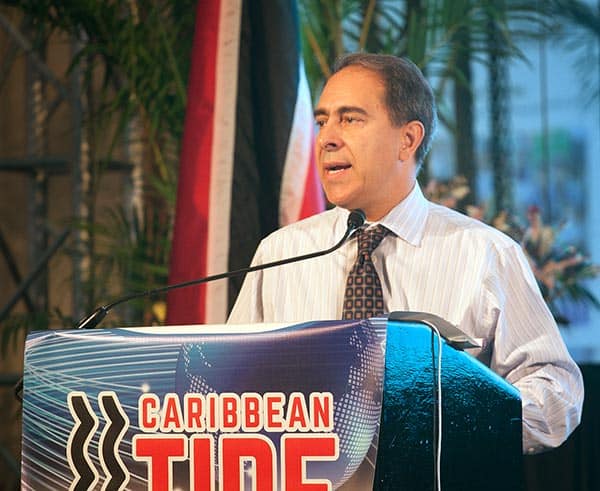
BitDepth#1005 for September 08, 2015
Image above: Doyle Gallegos of the World Bank Group speaking at the Caribbean TIDE conference. Photo by Mark Lyndersay.
Doyle Gallegos of the World Bank Group speaking at the Caribbean TIDE conference. Photo by Mark Lyndersay.On the second day of the Caribbean TIDE conference, the discussions surged more determinedly into the territory inferred by an event that took its acronym from technology and innovation for the digital economy.
The three-day event, which ran from the 25th through the 27th of August at the Trinidad Hilton explored many regional issues related to technology, but Wednesday morning brought regional bankers and ministers together to discuss ICT in regional governance and infrastructure, which are mission critical for any real growth in the archipelago.
The World Bank’s Doyle Gallegos discussed early findings from a global report exploring the “digital dividends” of the technology revolution.
That report, Gallegos stressed, was still in the information gathering stage, and its findings are still incomplete.
The findings on a global scale are what you might expect to find.
Internet use decreases market and non-market transaction costs, but the developmental consequences of that fundamental change have been, the World Bank is finding, counterintuitive.
According to early data from the report, in the digital age, global productivity has dropped, global inequality has expanded and the share of elections that are free and fair has also declined.
Taking a hit are the analog economies of innovation, creating a situation in which ICT tends to deliver between four and six per cent of GDP and one to two per cent of jobs while gobbling up 15-20 per cent of investment capital, and tending to create digital monopolies.
Mid-skilled jobs are shrinking in 20 of the 22 developing countries assessed for the report. If workers in that sector of the job market can’t upgrade their skills, they drift down to low-skilled work.
The dream of universal accessibility is on track, but only for voice and SMS messages, for which coverage is available for 6.8 billion people.
Of an estimated global population of seven billion, six billion have no broadband, four billion have no Internet and two billion have no access to mobile phones.
Only 1.1 billion people in the world have access to affordable high-speed Internet access.
This isn’t a problem for developing nations only.
According to Dr Arunas Slekys who consults with Global VSAT, a satellite based Internet provider, 10-12 per cent of US citizens are underserved, a total of 10-12 million people who the provider works to reach using its technology.
In India, satellite technology serves 100,000 public Internet access points in rural communities.
Global VSAT uses geostationary satellites capable of delivering 100GBps and newer models will be capable of 200GBps.
Digital learning is taking off in remote villages in India as a result, and as Dr Slekys noted, “store owners are making more money renting time on the Internet than they are selling goods in the store.”
Regionally, Alice Bain, project coordinator of the Caribbean Regional Infrastructure Communications Program (CARCIP), described a World Bank funded plan to increase access to regional broadband networks and develop an ICT based innovation economy in St Vincent and the Grenadines and Grenada.
The Grenadine islands currently use microwave technology for telecommunications which imposes a very low upper limit on bandwidth.
To build out a broadband solution for the chain of islands a 191km necklace-like festooning of cable (think Christmas tree lights), will be built to supply a VPN connected government network and to support capacity of 10MBps per 100 students for a one laptop/tablet per child ICT education plan.
“Broadband deployment is a critical component of the National ICT Plan for 2014-2018, SmarTT,” said Vashti Maharaj of the Ministry of Science and Technology.
According to the ministry’s representative, 147 communities in Trinidad and underserved, as is most of Tobago. Only the western tip of Tobago has access to wired broadband and the remainder of the island depends on a mobile signal.
The Technology Ministry has also been developing a proposal to improve T&T undersea cable connectivity, making use of the landing at Mission Bay in Toco which links Tobago to add a sixth cable landing on the northeast coast dubbed TT-1.
The existing five landings were all at Macqueripe Bay in Chaguaramas.
Clearly improving Internet access is critically important since the technology only drives development when it’s fast, affordable and always on.
Change will only be driven when universal, affordable Internet access is provided in a growth focused nation, something that Gallegos noted must sometimes be driven by public-private partnerships when the commercial market place fails to provide the service.
“Digital strategy needs to be broader than ICT strategy,” Doyle Gallegos said.
“We can no longer think of digital advancements as aligned with ICT, they must be part of all [governance] sectors.”



